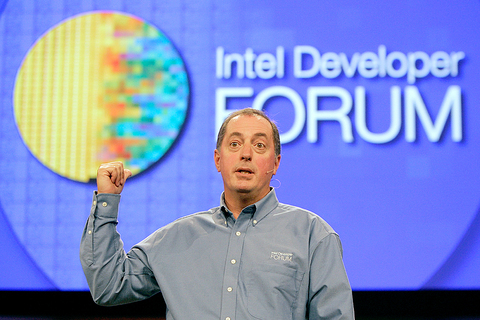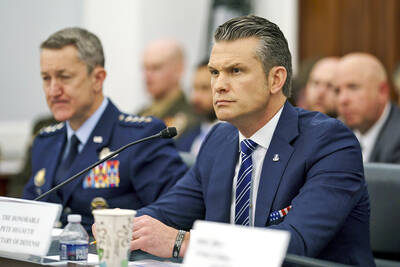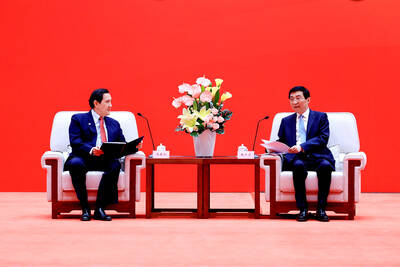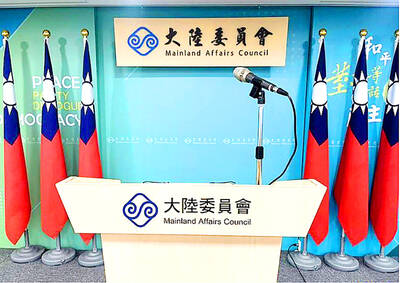The Intel battleship is turning.
Intel, the world's biggest chipmaker, has been struggling for a year to fend off a revitalized Advanced Micro Devices, which has a head start in "multicore" and low-power 64-bit microprocessors. On Tuesday, Paul Otellini, Intel's chief executive, sketched out a new plan to move the company forward on energy-saving computing, based on new multicore processors.
To position itself for that change, Intel undertook a deep reorganization six months ago to help speed the development of chips with internal designs that contain two or more internal processing units.

PHOTO: AFP
In a speech opening Intel's Annual Developer Forum in San Francisco on Tuesday, Otellini was upbeat about growth in the high-technology industries and expansion in emerging foreign markets. Both trends, he said, will enable Intel to grow through the rest of the decade.
"Rumors of the death of technology were greatly exaggerated," he said.
He said Intel has benefited from the market shift to laptop computers, which now outsell desktop machines internationally and for the first time outsold desktops in the US retail market in the second quarter of this year.
Energy-efficient computing, which can make possible more powerful servers and long-lasting laptop computers, was very much on Otellini's mind.
"We need to think about mea-suring performance against a new metric, and that is performance per watt," he said.
He said Intel's goals for microprocessor power consumption were five watts for a portable computer, 65 watts for desktop computers and 80 watts for server computers.
A new mobile microprocessor, code-named Yohan, which is intended to follow the Pentium M processor when it is introduced commercially in the first quarter of next year, will double the performance of the existing Pentium M processor family on a per watt basis, Otellini said.
To reach its low-power goals, Intel has decided to move away from its focus on processor speed and instead add dual-processor cores to each of its microprocessors, making it possible to execute instructions in parallel.
Beginning in 2007 the company will begin doubling the number of cores in each processor to four.
Otellini said energy-efficiency gains would be substantial in chips for PCs and servers.
He also mentioned a new ultra-low power version of the original X86 chip architecture, which would consume power equal to one-half watt. The new chip, which would be available sometime toward the end of the decade, would be used in a class of computer Otellini called "hand-tops."
Intel has slipped a new design under the hood of its X86 chips which will put new computing features deeper inside the microprocessor, out of sight of both computer users and software developers.

BUILDUP: US General Dan Caine said Chinese military maneuvers are not routine exercises, but instead are ‘rehearsals for a forced unification’ with Taiwan China poses an increasingly aggressive threat to the US and deterring Beijing is the Pentagon’s top regional priority amid its rapid military buildup and invasion drills near Taiwan, US Secretary of Defense Pete Hegseth said on Tuesday. “Our pacing threat is communist China,” Hegseth told the US House of Representatives Appropriations Subcommittee on Defense during an oversight hearing with US General Dan Caine, chairman of the Joint Chiefs of Staff. “Beijing is preparing for war in the Indo-Pacific as part of its broader strategy to dominate that region and then the world,” Hegseth said, adding that if it succeeds, it could derail

CHIP WAR: The new restrictions are expected to cut off China’s access to Taiwan’s technologies, materials and equipment essential to building AI semiconductors Taiwan has blacklisted Huawei Technologies Co (華為) and Semiconductor Manufacturing International Corp (SMIC, 中芯), dealing another major blow to the two companies spearheading China’s efforts to develop cutting-edge artificial intelligence (AI) chip technologies. The Ministry of Economic Affairs’ International Trade Administration has included Huawei, SMIC and several of their subsidiaries in an update of its so-called strategic high-tech commodities entity list, the latest version on its Web site showed on Saturday. It did not publicly announce the change. Other entities on the list include organizations such as the Taliban and al-Qaeda, as well as companies in China, Iran and elsewhere. Local companies need

CRITICISM: It is generally accepted that the Straits Forum is a CCP ‘united front’ platform, and anyone attending should maintain Taiwan’s dignity, the council said The Mainland Affairs Council (MAC) yesterday said it deeply regrets that former president Ma Ying-jeou (馬英九) echoed the Chinese Communist Party’s (CCP) “one China” principle and “united front” tactics by telling the Straits Forum that Taiwanese yearn for both sides of the Taiwan Strait to move toward “peace” and “integration.” The 17th annual Straits Forum yesterday opened in Xiamen, China, and while the Chinese Nationalist Party’s (KMT) local government heads were absent for the first time in 17 years, Ma attended the forum as “former KMT chairperson” and met with Chinese People’s Political Consultative Conference Chairman Wang Huning (王滬寧). Wang

CROSS-STRAIT: The MAC said it barred the Chinese officials from attending an event, because they failed to provide guarantees that Taiwan would be treated with respect The Mainland Affairs Council (MAC) on Friday night defended its decision to bar Chinese officials and tourism representatives from attending a tourism event in Taipei next month, citing the unsafe conditions for Taiwanese in China. The Taipei International Summer Travel Expo, organized by the Taiwan Tourism Exchange Association, is to run from July 18 to 21. China’s Taiwan Affairs Office spokeswoman Zhu Fenglian (朱鳳蓮) on Friday said that representatives from China’s travel industry were excluded from the expo. The Democratic Progressive Party government is obstructing cross-strait tourism exchange in a vain attempt to ignore the mainstream support for peaceful development